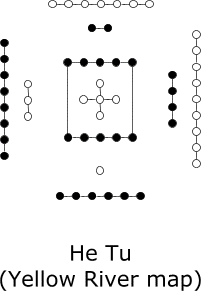
It is worth noting that numbers are traditionally thought to have characteristics depending on whether they are odd or even. Odd numbers are traditionally regarded as yang, and even numbers are yin; for example seven is yang, whereas eight is yin.

In the He Tu we can see that odd and even numbers are always paired: one and six, two and seven, three and eight, four and nine, and - in the central position - five and ten.
In the gua, the characteristic of yang are represented as an unbroken line, while yin is represented as a broken line. (For more details of yang and yin see Opposites and the Binary System.)


The gua of Fu Xi are composed of three tiers of lines (which may be either unbroken or broken). Let us now give each tier a numerical value where the middle tier is always equal to twice the base or lowest tier, and the uppermost tier is three times the base. We may create as many of these columns as we wish, but for now we are only interested in columns produced by numbers from one to ten.

The base tier gives the column its character (remember odd numbers are yang and even are yin).
Now we may begin to process the numbers of the He Tu, and the first step is to relate each of the eight gua - one at a time - to a pair of columns corresponding to one of the He Tu's pairs of numbers. Let us start with the He Tu pair one and six.
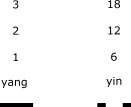
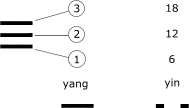
The bottom line, being yang, relates to column one (the bottom line = 1); the middle line, also yang, also relates to column one (the middle line = 2); and the upper line, also yang, also relates to column one (upper line = 3).
The total score, then, of this gua is a simple addition sum: 1 + 2 + 3 = 6.
Of course, most gua are a mixture of yang and yin, for example, Zhen.
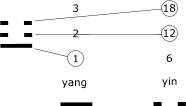
The bottom line, being yang, relates to column one (the bottom line = 1); the middle line is yin and therefore relates to column six (the middle line = 12); and the upper line, also yin, also relates to column six (upper line = 18).
The total score, then, of this gua is 1 + 12 + 18 = 31.
Each of the eight gua needs to be calculated.
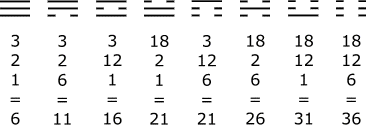
It is important to be familiar with this part of the method because we shall return to it before we are finished.
Second step
or return to the Introduction
© Ken Taylor 2006